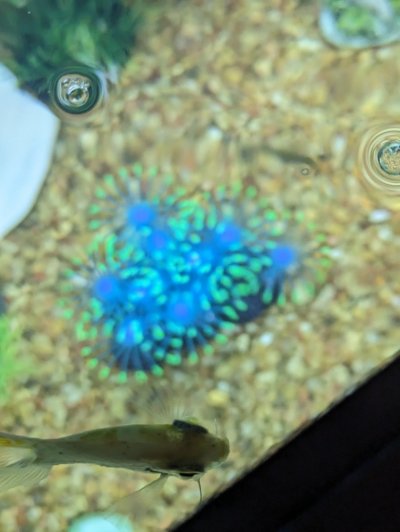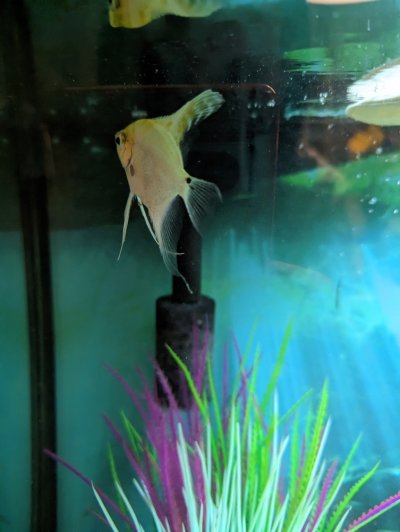Hi again!
So things were starting to get better. Maybe my tank started cycling. I also used the buffer stuff and it worked well. I noticed too the ammo lock drops my PH. Unfortunately my KH still stays at 0. I also noticed my angel likes the lower ph - in the high 6's.
Current parameters
28c
PH 6.4
Ammonia 0.25
Nitrite 0
Nitrate 0
GH 75
Total alkilinity 40
KH 0
My biggest issue right now is my angel isn't happy. Attached is a photo of her anal fin where the longest strand doesn't look right looks likes it has white bacteria or slime on it. and the same thing is happening to her ventral fin. I noticed that the longest strand has now fallen off her anal fin. She also has that shiny spot on her head which may be lymphocytes? Anyway, she's usually excited to see me but now she looks more anxious. Flapping her fins and breathing quickly. I fed her and that seemed to calm her down. And she's glass surfing. I just don't know what this could be because the parameters are improving .
Also one of my tetras died (not the one from the original post). Pretty sure it was that neon disease - swollen abdomen. The one thing that was odd was when I found the body there was bacteria that looked hairy, like white cotton.
I did the water test for gravel with tap water and some of my gravel in a bucket and here are the readings after a week
0nitrite
0 nitrate
GH 25
KH 80
PH 7.2
My regular tap water when I first tested it was
Ph7.8
Nitrite 0
Nitrate 5
GH 120
KH 80
So not much of a difference between the 2. I'm stuck. I just want to prevent my angel from getting/being sick and stressed. Thanks!
So things were starting to get better. Maybe my tank started cycling. I also used the buffer stuff and it worked well. I noticed too the ammo lock drops my PH. Unfortunately my KH still stays at 0. I also noticed my angel likes the lower ph - in the high 6's.
Current parameters
28c
PH 6.4
Ammonia 0.25
Nitrite 0
Nitrate 0
GH 75
Total alkilinity 40
KH 0
My biggest issue right now is my angel isn't happy. Attached is a photo of her anal fin where the longest strand doesn't look right looks likes it has white bacteria or slime on it. and the same thing is happening to her ventral fin. I noticed that the longest strand has now fallen off her anal fin. She also has that shiny spot on her head which may be lymphocytes? Anyway, she's usually excited to see me but now she looks more anxious. Flapping her fins and breathing quickly. I fed her and that seemed to calm her down. And she's glass surfing. I just don't know what this could be because the parameters are improving .
Also one of my tetras died (not the one from the original post). Pretty sure it was that neon disease - swollen abdomen. The one thing that was odd was when I found the body there was bacteria that looked hairy, like white cotton.
I did the water test for gravel with tap water and some of my gravel in a bucket and here are the readings after a week
0nitrite
0 nitrate
GH 25
KH 80
PH 7.2
My regular tap water when I first tested it was
Ph7.8
Nitrite 0
Nitrate 5
GH 120
KH 80
So not much of a difference between the 2. I'm stuck. I just want to prevent my angel from getting/being sick and stressed. Thanks!


